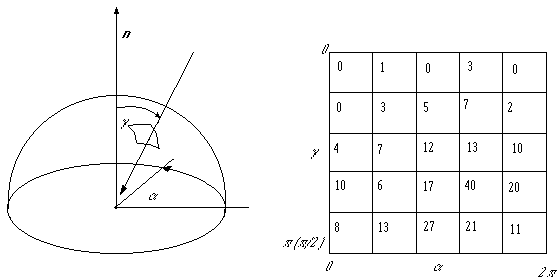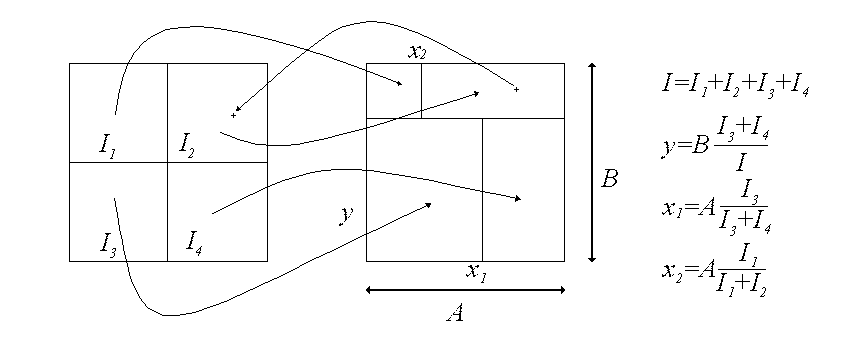Next:Our work Up:Contents
Previous:Mesh generators
An importance sampling technique using the particle distribution
To evaluate the rendering equation, Monte Carlo integration
techniques can be used. In these methods we sample the integrand at random
directions. Random sampling is very inefficient, because we have a very
small chance to pick a direction where significant amount of light can
come from. It would be a good idea to sample the integrand from directions
contributing most of the outgoing radiance, so another algorithm, importance
sampling can be used. The basic idea behind importance sampling is to place
more samples where the integrand function is larger. The sampling
can be described with:
 ,
,
where  is a
probability density in
is a
probability density in  ,
the
,
the  points
are selected according to this probability density, and
points
are selected according to this probability density, and  is the variance. The variance can be minimized if
is the variance. The variance can be minimized if  is proportional to the integrand
is proportional to the integrand  .
.
A path tracer works in the following way: we generate
a starting direction from the camera. We examine whether a surface is hit
or the particle leaves the scene. If a surface has been hit, we generate
a new direction. In case of importance sampling this new direction
depends on some kind of knowledge about important directions. We
continue this process until a lightsource has been reached or the photon
leaves the scene. At each reflection point we have to scale the calculated
radiance according to the probability distribution of the importances.
If we examine the rendering eqation:
 ,
,
we can see that an impotance sampling algorithm can use the physical characteristic
of the surface (its BRDF) to generate the important directions. With the
outgoing direction and the BRDF we can select the incoming directions which
carries most of the radiance. This algorithm does not need to have knowledge
about the global illumination at the surface, which is also part of the
rendering eqation.
We can use the particle data to drive an importance
sampler in a path tracer algorithm. For this algorithm the important properties
of a particle are its power, its position in the scene and its incoming
direction.
How to generate important directions
We are interested in generating directions which contribute most of
the outgoing radiance at . We estimate the incoming radiance using the
generated particle distribution in the scene. This importance sampling
technique is presented in [5]. At a surface point we construct a hemisphere
or a sphere (if the surface is diffusely transparent) which will describe
the important sampling directions. We build this importance map by the
following algorithm:
-
Initialise the (hemi)sphere to zero in each region
-
Find the N nearest neighbour of the point currently hit. This N is a fixed
number during the algorithm.
-
Assume that each neighbour has been reflected at
 .
For each neighbour, calculate the product of the incoming power of the
particle and the BRDF. The BRDF is evaluated in the direction of the sampling
ray, and the direction of the incoming particle.
.
For each neighbour, calculate the product of the incoming power of the
particle and the BRDF. The BRDF is evaluated in the direction of the sampling
ray, and the direction of the incoming particle.
-
Add this value to the region which contains the particle’s incoming direction.
-
When every particle’s contribution is added to the sphere, distribute a
small portion of the total importance in the sphere among each region.
This operation is important, because only this way can the algorithm generate
sampling rays in directions where no particle came from.
-
Generate a new sampling direction.
-
Scale the returned radiance. Because importance sampling is used, we have
to scale the radiance returned by the sampling ray. The scaling factor
is:
Figure 5 shows a hemisphere, and an importance map. To decide how many
regions should an importance map have, we have to run simulations, and
measure the quality of the images and the computation times.

Figure 5: Left: a hemisphere with an incoming photon direction. Right:
an importance map
To generate an outgoing sampling direction, we
have two possibilities. The first method is based on mip-mapping. We demonstrate
this algorithm in a case where we have just four areas with importances
I1, I2, I3 and I4. This transformation decomposes a rectangle of size A
x B to four subrectangles having an area proportional to the importances
of the original rectangles. Then we generate a uniformly distributed random
point in the transformed rectangle. We find the original rectangle for
this point and scale it’s coordinates to represent a point in the original
rectangle. Figure 6 illustrates this method.

Figure 6: The mip-map based generation of a sampling direction
The second method is a kind of a linear inversion technique.
This method takes advantage of the fact that the inportance map is discretized,
thus it can be considered as a one-dimensional, row continous array. The
algorithm selects an element of this array proportional to its importance.
We sum all the importance weights of the areas and generate a random number
in the range of  ,
where I is the sum. Then we scan the rows of the importance map
and sum up the importance values. When this sum becomes greater than the
generated random number, we select the last region whose weight was added
to the sum. Then we can generate a random point in the selected region.
Figure 7 shows how this algorithm works.
,
where I is the sum. Then we scan the rows of the importance map
and sum up the importance values. When this sum becomes greater than the
generated random number, we select the last region whose weight was added
to the sum. Then we can generate a random point in the selected region.
Figure 7 shows how this algorithm works.
Figure 7: Selecting a region with random number .
![[CESCG logo]](../../CESCG/images/cescg98.small.gif)
![[CESCG logo]](../../CESCG/images/cescg.small.gif)
![[CESCG logo]](../../CESCG/images/cescg98.small.gif)
![[CESCG logo]](../../CESCG/images/cescg.small.gif)


